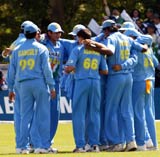
|

Soon, there'll be 12 in that huddle, not 11
© Getty Images
|
|
A few months ago, Cricinfo received feedback on how to make the one-day game more interesting. Some seemed viable, and many were radical. But nearly every one of them agreed that the game needed to be changed in some way. The question was, how?
The ICC's Cricket Committee has walked this tightrope rather well. It has not suggested telling individual boards to produce more responsive pitches, nor has it recommended regulations to check Australia's dominance. It has instead recognised that one of the game's major problems lay in its rigidity, and that is what it has sought to rectify.
The recommendations of the panel chaired by Sunil Gavaskar are about offering flexibility. Umpires, captains, teams will have options: options over lbw decisions, over when to apply fielding restrictions, over which player to substitute. This is a remarkable development for it is a clear sign that there is intent to revive the one-day game, even if it means breaking with tradition.
One-day cricket needs these changes. Both Tests and the hoopla about Twenty20 have overshadowed it. Yes, there have been too many one-dayers played in recent years, but they are still profitable - and you can't argue with commerce. But at the moment, it is a game that is neither here nor there. It is not a place for bowlers, as Tests can be, and as for big hitting, Twenty20 has cornered that market. These changes will add variety and make one-dayers stand out again. It is, after all, a spectacle. And this leaves Test cricket's sanctity intact.
The familiar routine of bash-bash-knock it about for singles-and then bash some more will be done with, thanks to the new fielding restrictions: increasing them to 20 overs, of which ten can be used in two five-over blocs at any time by the fielding captain. The criticism of this proposal - that the move will only complicate the game further - is misplaced. Cricket has never pretended to be a simple game. This is just another variable to use and to deal with, and adds to the game's depth. This keeps the action constant and breaks up the predictability. It is, in a way, in keeping with the times. What the times demand are bigger audiences, more action, more drama, more everything.
Even the most contentious of the proposed changes - to allow substitutions - fits in with the need for modern sport to reinvent itself from time to time. While its benefits might not be apparent immediately, it will provide captains flexibility to switch a player for tactical or other reasons. And flexibility isn't a bad thing.
Empowering the umpires with technology is another good idea, for it could reduce the chance of error. For far too long has there been resistance to this, though this is now changing. While cricket attempted to become professional, its umpires - and in which other sport do decisions hinge so much on the umpire? - continued to make mistakes. It is anything but charming. It makes sense, then, to reduce errors in every way possible.
However, none of these changes, except the use of technology, help bowlers. So what can? Barring any major lbw- or bouncer-rule changes, there is one option: changing the composition of cricket balls so they swing or bounce or spin more. Balls have been made the same way for over a hundred years though, in that time, rules have continued changing to suit batsmen to the point that these encounters are one-sided. Though commercial considerations are necessary - a match that goes over or ends before the stipulated time is bad for rigid TV scheduling - it would be dangerous to ignore the battering bowlers receive, because their actions help create contests.
The changes suggested by the ICC will serve to renew interest - even if it is only curiosity. Now if only they'd help the poor bowlers.
Rahul Bhatia is staff writer of Cricinfo.
